Simply put, the term preposition literally means, ‘something put before’ and is a key part of learning Italian. A preposition is a word or short phrase that explains how something relates to the rest of the sentence. Examples of some English prepositions include: at, for, with, into, from, in front of and near to.
As in English, Italian prepositions are placed before a noun or a pronoun to connect two pieces of information. For example, I’m at home; It’s for her; She’s on the train, and It’s in front of him.
Learning what the major prepositions are is easy enough, the tricky part for language learners is understanding which one is the correct preposition. This is incredibly important because otherwise you change completely change the whole meaning of a sentence.
In this guide, we’ll focus on how to use each Italian preposition and where to place it within the sentence.
Main Italian Prepositions
Along with the most common Italian words, it’s important to learn the most common prepositions in Italian and their general meanings. I say ‘general’, because their meanings may vary, which we will explore. These are called simple prepositions.
- a (to, at)
- di (of)
- da (from)
- in (in)
- su (on)
- con (with)
- per (for)
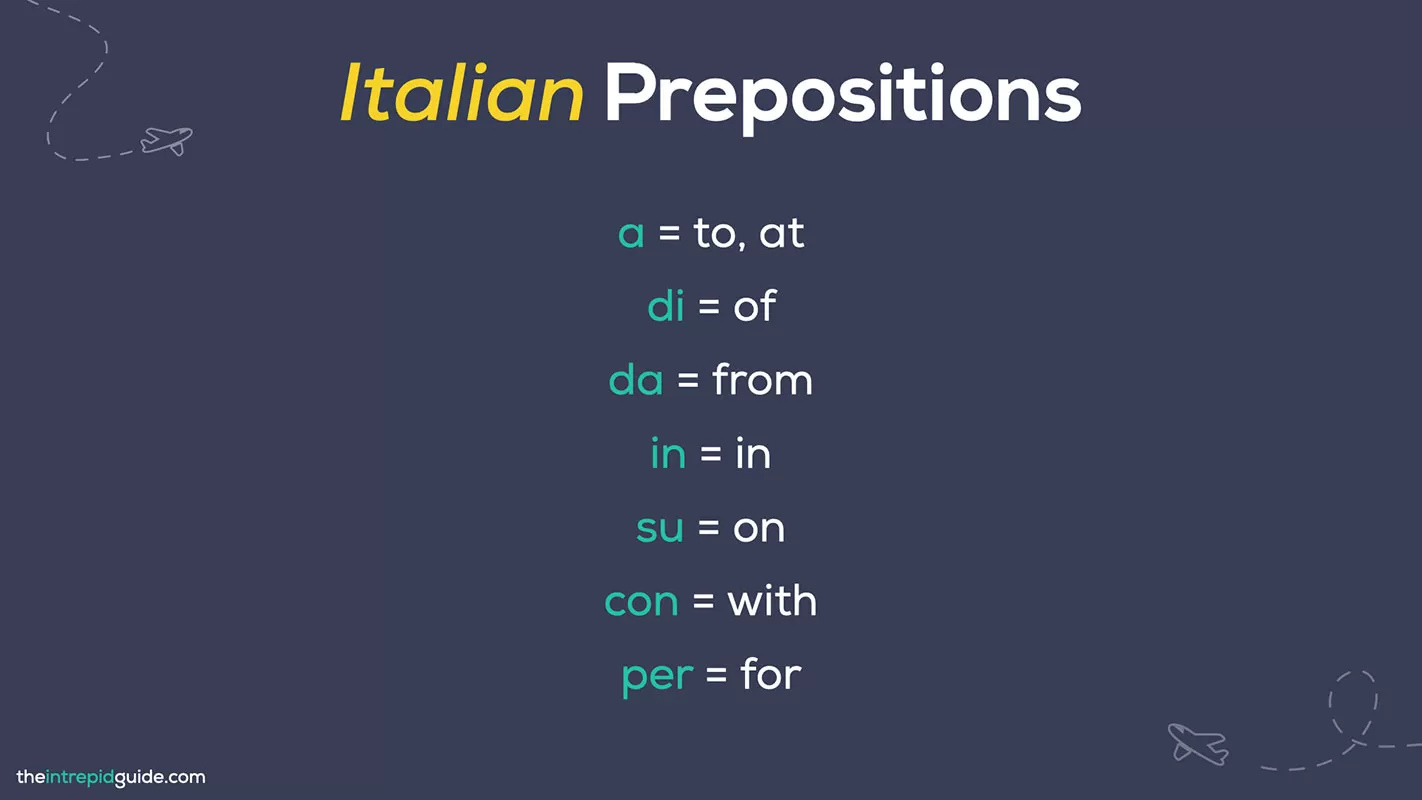
Articulated Prepositions: Prepositions that combine with definite articles
When the simple prepositions a, di, da, in and su are followed by the definite article – il, la, i, le and so on, they combine (or contract) with the definite article to form one word. These are called articulated prepositions. For example, a + il = al. You can think of this contraction like the English ‘it is’ to ‘it’s’. It helps with phonetics and contributes to the flow and melody of the language.
Contracted Italian Prepositions Chart
Here’s a chart of all the possible variations for the prepositions we saw earlier and the articulated preposition for each.
| Italian Preposition / Definite Article | + il | + lo | + la | + l’ | + i | + gli | + le | English Translation |
|---|---|---|---|---|---|---|---|---|
| a | al | allo | alla | all’ | ai | agli | alle | to/at the |
| di | del | dello | della | dell’ | dei | degli | delle | of the |
| da | dal | dallo | dalla | dall’ | dai | dagli | dalle | from the |
| in | nel | nello | nella | nell’ | nei | negli | nelle | in the |
| su | sul | sullo | sulla | sull’ | sui | sugli | sulle | on the |
| con | con il | con lo | con la | con l’ | con i | con gli | con le | with the |
| per | per il | per lo | per la | per l’ | per i | per gli | per le | for the |
Once upon a time in Italian, the prepositions con and per were combined with the definite article to form variations of col and pel and so on, this is now a thing of the past. However, in spoken Italian you may still hear con combined with the definite article. For example: Matteo deve parlare col suo capo (Matteo has to speak to his boss).
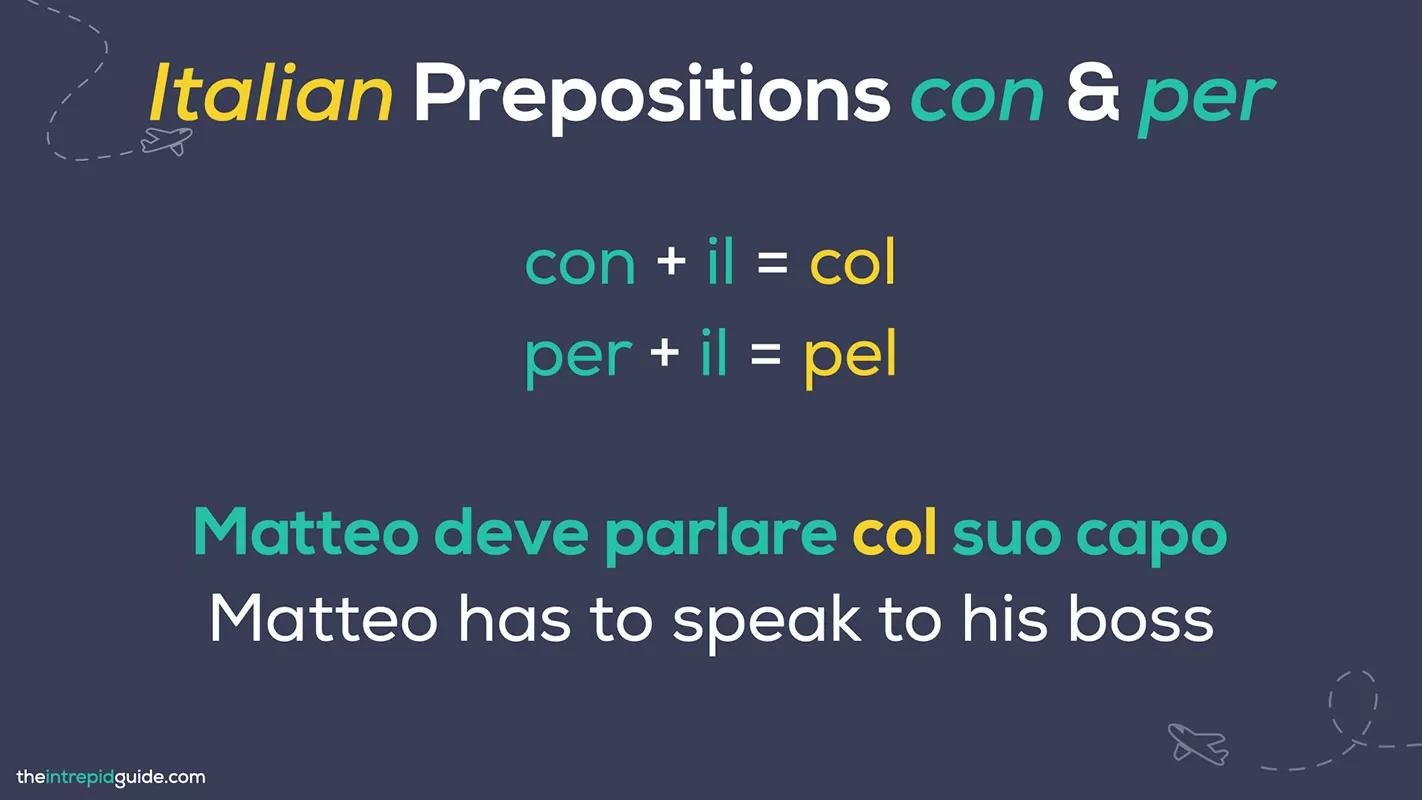 Here are some examples of Italian sentences using the prepositions in the table:
Here are some examples of Italian sentences using the prepositions in the table:
- Lei si guarda sempre allo specchio – She’s always looking at herself in the mirror
- Silvia è scesa dal treno – Silvia got off the train (Literally: ‘Silvia came down from the train’)
- I passaporti sono sul tavolo – The passports are on the table.
- Uno per uno – One by one
- Con le buone o con le cattive – Come hell or high water / No matter what it takes [An idiomatic expression literally: ‘With the good or with the bad’]
- Ho le farfalle nello stomaco – I have butterflies in my stomach [An idiomatic expression for feeling nervous or excited]
- Voglio visitare la Galleria degli Uffizi a Firenze – I want to visit the Uffizi Gallery in Florence (Literally: ‘I want to visit the Gallery of the Uffizi’)

Other common Italian prepositions
There are many other prepositions which you should also familiarise yourself with. These include:
- con (with)
- senza (di) (without)
- attraverso (across, through)
- contro (di) (against)
- dietro (di) (behind)
- davanti a (in front of)
- accanto a (beside, next to)
- di fronte a (opposite)
- in fondo a (at the bottom of)
- sopra (di) (above)
- sotto (under, below)
- oltre (beyond)
- in mezzo a (in the middle of)
- dopo (di) (after)
- prima (di) (before)
- entro (by + point in time) eg. Dobbiamo finire entro domani – We have to finish by tomorrow
- tra/fra (between) – these have exactly the same meaning and can be used interchangeably

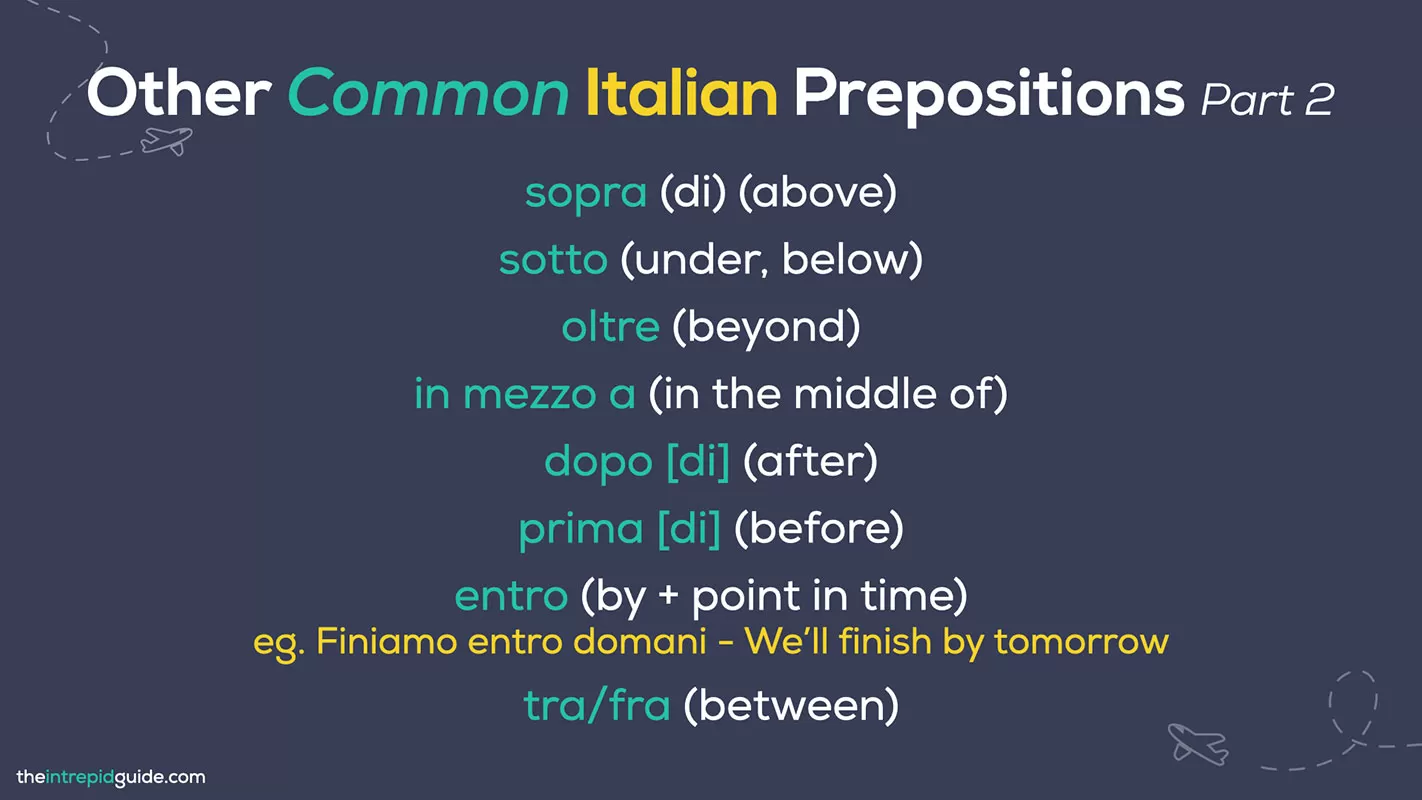 When to use each Italian preposition
When to use each Italian preposition
Learning prepositions in any foreign language is a challenge and Italian is no exception. This is because the prepositions used can vary not only between languages but also according to expressions and verbs.
Quite often the preposition you use in Italian will be similar to what you would say in English, however, many of them may not be what you expect. One example is that a can mean ‘to’, ‘in’, ‘at’, or even ‘on’ in some cases. For example:
- Vado al cinema – We’re going to the cinema
- Vogliono venire al mare? – Do they want to come to the beach?
- Abito a Londra– I live in London
- Roberto è al telefono – Robert is on the phone
Then there are certain prepositions used with Italian verbs that relate to a specific place. For example, arrivare (to arrive) is always followed by the preposition a (at/to/in) when referring to a city, but when you arrive in a country, you use the preposition in (in).
Partire (to leave, depart) is always followed by the preposition da (from) when leaving from a place; when leaving for a place it is followed by the preposition per (for). Here are some examples:
- Luca parte da Torino alle cinque – Luca leaves (from) Turin at 5 o’clock
- Arrivo a Taormina nel pomeriggio – I’m arriving in Taormina in the afternoon
- Parto per Roma domani mattina – I leave for Rome tomorrow morning
Unfortunately, there is no magic rule for learning prepositions, just lots of use cases! So it makes sense for you to learn how they are used as you go along. With that said, here are some specific rules you can learn and apply.
How to use the preposition A
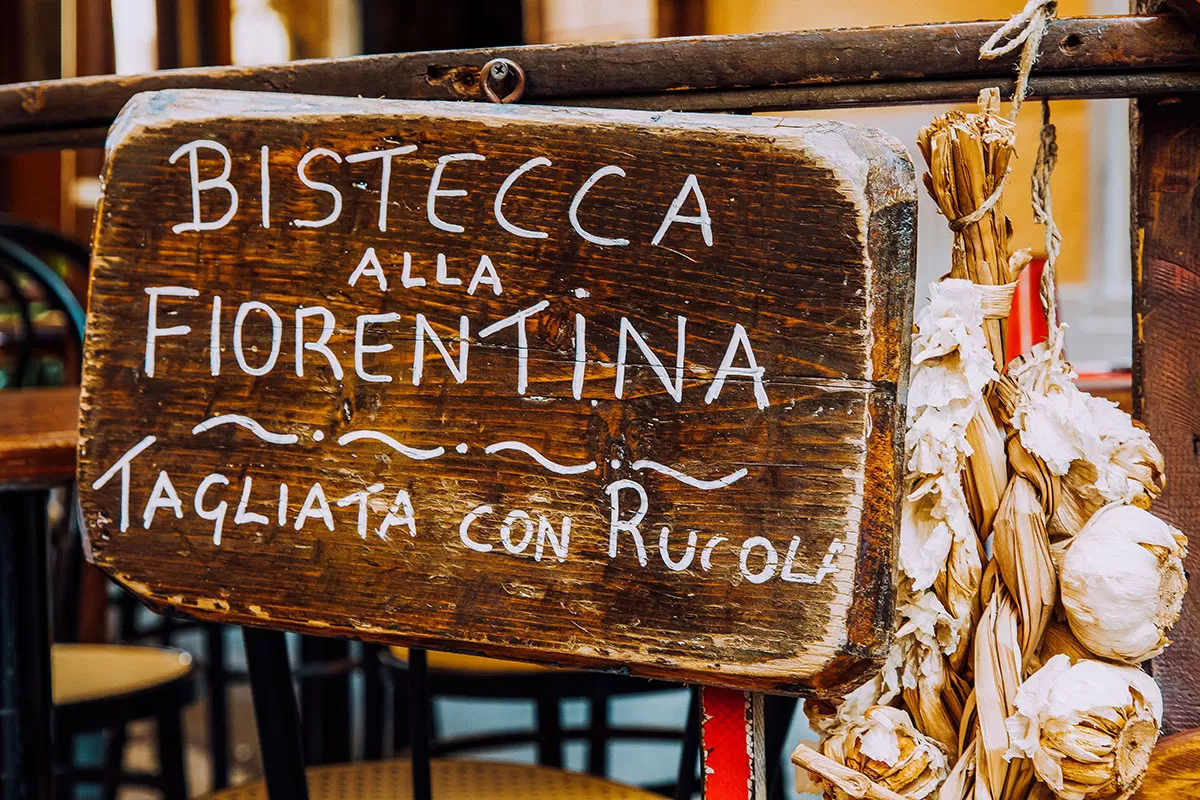 The preposition a is used:
The preposition a is used:
1. When talking about being in a town or city:
- I miei abitano a Torino (My parents live in Turin)
- Ho abitato a Bologna per tre anni (I lived in Bologna for 3 years)
Otherwise, in is used if the place is a country:
- Maria vive in Italia (Maria lives in Italy)
- Vivono in Scozia (They live in Scotland)
- Vive in Canada (He/She lives in Canada)
- Vivi in Australia? (Do you live in Australia?)
Don’t miss my guide to how to say 170+ countries and nationalities in Italian
Attenzione! You use the definite article as well as in with countries that are plural:
- Devo andare negli Stati Uniti (I have to go to the United States)
- Vivono nei Paesi Bassi (They live in the Netherlands)
2. With nouns to tell you where something is:
- Sto alla porta (I’m at the door)
- Voglio un posto al sole (I want a place in the sun)
- Ci siamo seduti all’ombra (We sat in the shade)
- Vive al secondo piano (He/She lives on the second floor)
- I bambini sono a letto (The children are in bed)
- Abbiamo sentito la notizia alla radio (We heard the news on the radio)
- Guardiamo la partita alla TV? (Shall we watch the game/match on TV?)
3. When talking about going to a place:
- Sono andato al ristorante (I went to the restaurant)
- Sei mai stato a Londra? (Have you ever been to London?)
Attenzione! When going to a country, use in:
- Vuoi andare in Sicilia quest’estate? (Do you want to go to Sicily this summer?)
For more, visit my definitive guide to countries and nationalities in Italian
4. When talking about being at a place:
- Devo essere all’aeroporto alle nove (I must be at the airport at nine)
- Scendiamo alla prossima fermata (We get off at the next stop)
- Chiara è a casa? (Is Chiara at home?)
5. When talking about distances:
- Abito a tre chilometri da qui (I live three kilometres away from here)
- Roma è a due ore di distanza in macchina (Rome is two hours away by car)
- A due passi da qui (Very close, A stone’s throw away) [An expression literally meaning; ‘At two steps from here’)
6. With nouns to tell you when:
- A volte vado al mare (At times/Sometimes I go to the beach)
- A tempo (On time)
- Alla fine abbiamo deciso di trasferirci in Brasile. (In the end/Finally we decided to move to Brazil)
7. With times and festivals:
- Ci vediamo stasera alle otto (See you tonight at 8 o’clock)
- Pranzo a mezzogiorno (I have lunch at noon/midday)
- A Pasqua mangiamo le uova di cioccolato (At Easter we eat chocolate eggs)
- A Natale ci scambiamo i regali (At Christmas we exchange gifts)
- A che ora apre? (What time does it open?)
8. With months to mean in:
- Sono nata a dicembre (I was born in December)
9. With nouns to tell you how something is done:
- Vado al lavoro a piedi (I go to work on foot)
- L’ho fatto a mano (I made it by hand)
- A poco a poco imparo l’italiano (Little by little I’m learning Italian)
10. When talking about flavours:
- Un gelato alla fragola (A strawberry ice-cream)
- Una torta al cioccolato (A chocolate cake)
- La pasta con il sugo al pomodoro (With with tomato sauce)
11. With nouns and pronouns after some verbs:
- L’ho dato a Eleonora (I gave it to Eleonora)
- Piace a me, ma a mio fratello no (I like it, but my brother doesn’t)
- A che cosa stai pensando? (What are you thinking about?) [Literally: ‘To what are you thinking?’]
How to use the preposition DI
 The preposition di is used:
The preposition di is used:
1. When talking about who or what something belongs to:
- Il nome del parco (The name of the park)
- È di Giulia (It belongs to Giulia)
- Di chi è? (Whose is it?) [Literally: ‘Of who is it?’]
2. To refer to the person who made something:
- Un quadro di Caravaggio (A painting by Caravaggio)
- Una commedia di Shakespeare (A play by Shakespeare)
- Un film di Fellini (A Fellini film / A film by Fellini)
3. To express ownership:
In English, ownership is shown by adding ‘s, or s’ for example ‘Michele’s pizza’. In Italian, we need to change the word order and use the preposition di to translate this type of phrase:
- La macchina di mio padre (My father’s car) [Literally: ‘The car of my father’]
- La casa dei nostri amici (Our friends’ house)
- l’Otello di Verdi (Verdi’s Othello)
4. When there is a connection between two things
In English, when there is a connection between two things, one noun can be used in front of another, for example the car keys, the kitchen door. In Italian, we need to change the word order and use the preposition di to translate this kind of phrase:
- il tavolo della cucina (the kitchen table)
- il periodo delle vacanze (the holiday season)
- il professore di inglese (the English teacher)
- il campione del mondo (the world champion)
5. When a noun such as cotton, silver, paper is used as an adjective:
- una maglietta di cotone (a cotton T-shirt)
- una collana d’argento (a silver necklace)
- dei tovaglioli di carta (paper napkins)
6. To express ‘from’:
- È di Firenze (He’s from Florence)
- Di dove sei? (Where are you from?)
7. What something contains or what it is made of:
- Un gruppo di turisti (A group of tourists)
- Un bicchiere di vino bianco (A glass of white wine)
- È fatto di legno (It’s made of wood)
8. After certain numbers
After milione (million), and words for approximate numbers, such as un migliaio (about a thousand) and una ventina (about twenty):
- Ho vinto un milione di dollari! (I won a million dollars!)
- C’era un migliaio di persone al concerto (There was about a thousand people at the concert)
- Davide ha una ventina di macchine (David has about twenty cars)
Learn more about Italian numbers and how to count to a billion with my guide.
9. After certain verbs and adjectives:
- Ti ricordi di Roberto? (Do you remember Roberto?)
- Sto tentando di concentrarmi (I’m trying to concentrate)
- Le arance sono ricche di vitamina C (Oranges are rich in vitamin C)
- Era pieno di gente (It was full of people)
Some Italian verbs are single words in English, but in Italian, they are phrases ending with di, such as:
- avere bisogno di (to need)
- avere voglia di (to want/feel like)
Here are some examples:
- Non ho bisogno di un taxi (I don’t need a taxi)
- Non ho voglia di stare a casa (I don’t want to stay at home)
10. With nouns to say when:
- di giovedì (on Thursdays)
- di notte (at night)
- di giorno (during the day)
- di mattina (in the morning)
- di sera (in the evening)
11. With seasons and parts of the day:
- d’estate (in summer)
- d’inverno (in winter)
12. To make comparisons meaning ‘than’:
- Lei più alto di lui (She is taller than him)
- Sono più brava di lui (I’m better than him)
As seen above, di can be used before a pronoun:
- senza di lei (without her)
- contro di te (against you)
13. After a superlative:
- il più grande del mondo (the biggest in the world)
- il migliore d’Italia (the best in Italy)
14. To mean some:
When di is combined with the definite article it means ‘some’:
- Ci sono delle persone (There are some people)
- Vuoi dei biscotti? (Do you want some biscuits/cookies?)
15. With verbs in the infinitive when it is used as a noun:
- Hanno paura di volare (They are afraid of flying) [Literally: ‘They have fear of flying’]
- Non ho voglia di lavorare (I don’t feel like working)
- Hanno bisogno di aiuto (They need help) [Literally: ‘They have need of help’]
Verbs and idiomatic expressions that use di before an infinitive
There are many common expressions that you will often hear and use yourself. The following expressions are formed by using the Italian preposition di + infinitive. Notice how the preposition in English changes from one verb to the next.
| Italian expression | English translation | Italian expression | English translation |
|---|---|---|---|
| accettare di… | to agree to / accept | sperare di… | hope to |
| ammettere di… | to admit to | avere intenzione di… | to intend to |
| chiedere di… | to ask for | offrire di… | to offer to |
| avere paura di… | to be afraid of | ordinare di… | to order to |
| avere voglia di… | to be in the mood for / feel like | permettere di… | to permit to |
| avere ragione di… | to be right about | pregare di… | to pray to |
| credere di… | to believe in | ricordare di… | to remember to |
| decidere di… | to decide to | ripetere di… | to repeat to |
| sognare di… | to dream of | rispondere di… | to respond to |
| aspettare di… | to expect to | dire di… | to say to |
| finire di… | to finish | parlare di… | to speak of |
| dimenticare di… | to forget to | pensare di… | to think of |
| avere bisogno di… | to have need of/ to need | cercare di… | to try/attempt to |
Here are some examples:
- Credo di sì – I think/believe so
- Ho voglia di uscire stasera – I feel like going out tonight
- Ha paura di volare – He/She is afraid of flying
- Maria sogna di sposarsi – Maria dreams of getting married
- Ho dimenticato di chiamare Marco – I forgot to call Marco
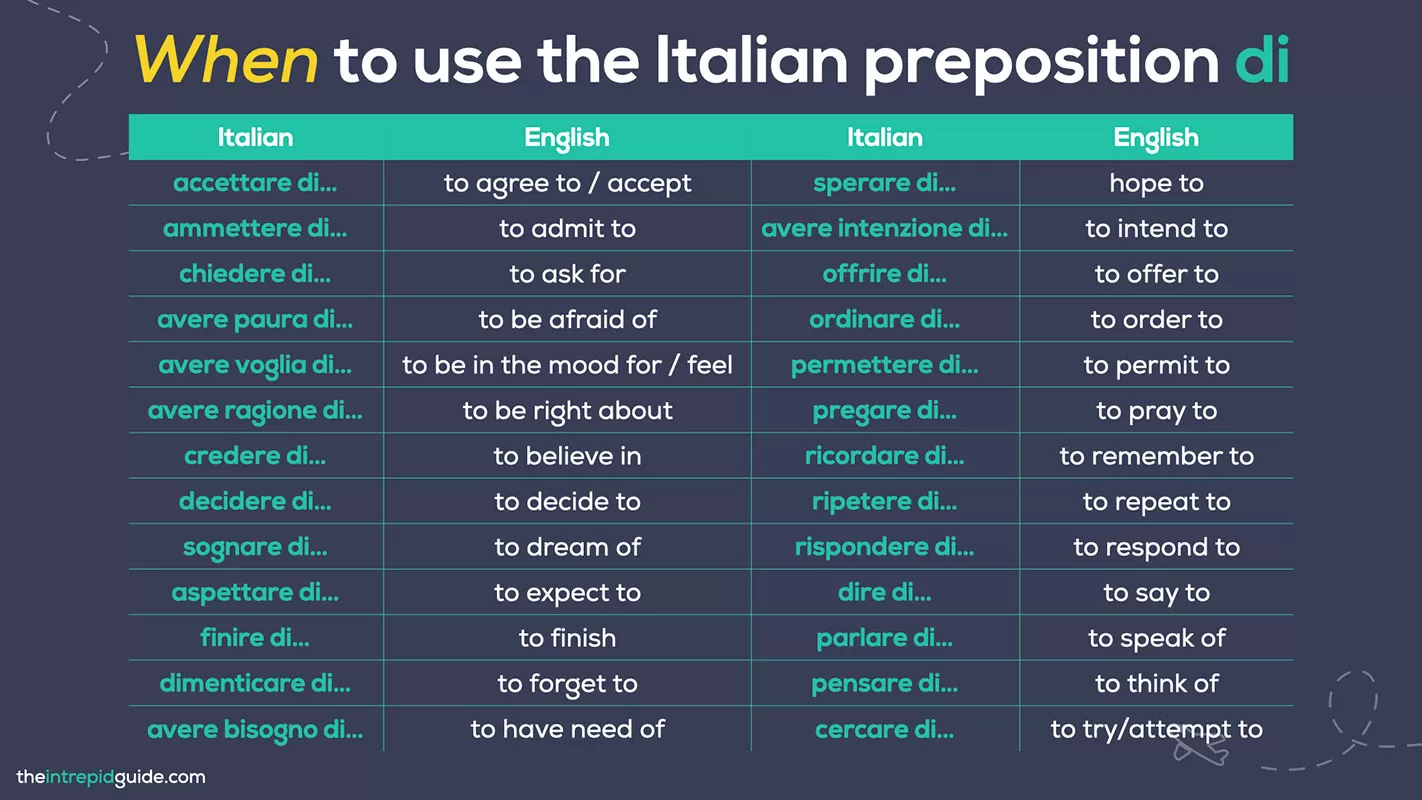
Verbs and idiomatic expressions that use a before an infinitive
Just as we saw with di, there are also several common expressions that use the preposition a + infinitive. Again, take note of how the preposition in English changes from one verb to the next.
| Italian expression | English translation | Italian expression | English translation |
|---|---|---|---|
| stare a … | to be at | aiutare a … | to help to |
| stare attento a … | to be careful to | invitare a … | to invite to |
| essere pronto a … | to be ready to | imparare a … | to learn to |
| cominciare a … | to begin/start to | passare a … | to pass to |
| portare a… | to bring to | preparare a … | to prepare for/to |
| venire a… | to come to | tornare a … | to return/go back to |
| entrare a… | to enter into | correre a… | to run to |
| uscire a… | to exit to | riuscire a … | to succeed at, manage to |
| andare a… | to go to | insegnare a … | to teach to |
Here are some examples:
- Cominciamo a guardare il film tra 5 minuti – We will begin watching the film in 5 minutes
- Maria impara a parlare l’italiano – Maria is learning to speak Italian
- Domani vieni a trovarmi? – Will you come (to) visit me tomorrow?
- Chiara è riuscita a passare l’esame – Chiara succeeded in passing the exam
- Devo tornare a lavorare – I have to go back to work
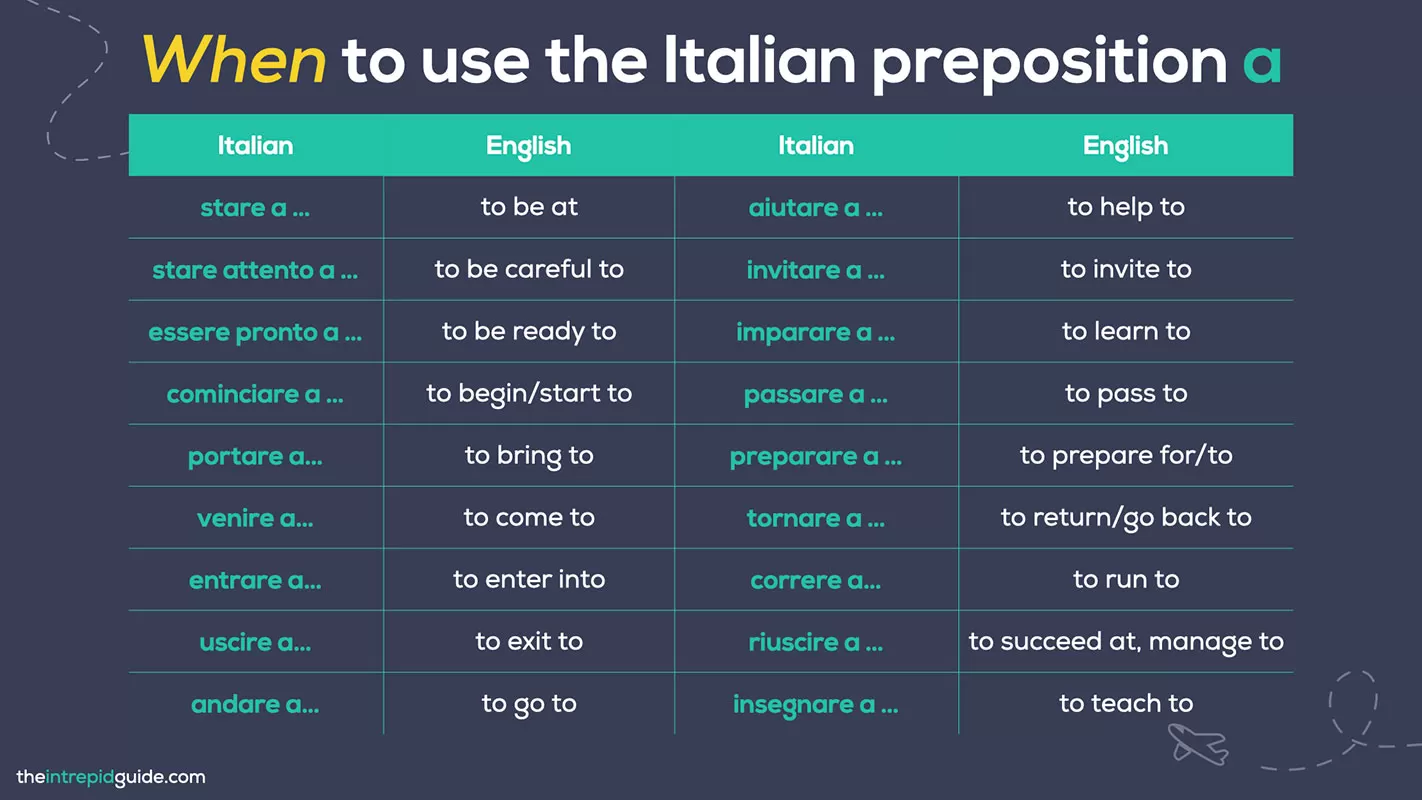
How to use the preposition DA The preposition da is used:
The preposition da is used:
1. With places to mean from:
- A cinque chilometri da qui (Five kilometres from here)
- Viene da Palermo (He comes from Palermo)
2. When getting, jumping or falling off something, or getting or falling out of something:
- Tomaso è sceso dal treno (Tomaso got off the train)
- Sono cascato dal letto (I fell out of bed)
- Il gatto è saltato dal muro (The cat jumped off the wall)
- È scesa dalla macchina (She got out of the car)
3. To say to:
- Da cima a fondo (From top to bottom)
- Lavoro dalle nove alle cinque (I work from nine to five o’clock)
4. With andare (to go) to say you’re going to a shop, someone’s house or workplace:
- Vado dal giornalaio (I’m going to the newsstand)
- Sono andata dal dentista ieri (I went to the dentist’s yesterday)
- Andiamo da Marta? (Shall we go to Marta’s house?)
5. With essere (to be) to say you’re at a shop, someone’s house or workplace:
- Laura è dal parrucchiere (Laura’s at the hairdressers)
- Sono da Francesca (I’m at Francesca’s house)
6. To talk about how long something has been happening:
Use da to refer to periods of time to mean for:
- Vivo a Dublino da un anno (I’ve been living in Dublin for a year)
Use da when referring to points in time to mean since:
- Da allora (Since then)
- Ti aspetto dalle quattro (I’ve been waiting for you since four o’clock)
Attenzione! The present tense (not the past tense) is used in Italian to talk about what has been happening for a period, or since a certain time.
- È a Siena da martedì (He’s been in Siena since Tuesday)
7. With passive verbs and passive sentences to mean by:
- È stata scolpita da Michelangelo (It’s sculpted by Michelangelo)
- La pizza è stata fatta dal pizzaiolo (The pizza was made by the pizza maker)
- Quest’opera è stata scritta da Puccini. (This Opera was written by Puccini)
8. With verbs in the infinitive when talking about things to do:
- C’è molto da fare (There’s lots to do)
- È un film da vedere (It’s a film that you have to see)
- Non c’è niente da mangiare (There’s nothing to eat)
- E da bere? (And [what would you like] to drink?)
9. To say what something is used for
The Italian preposition da is also used to say what something is used for. For example: a racing car, an evening dress. In Italian, you change the word order and use da.
- Mi sono comprato un nuovo paio di scarpe da corsa (I bought myself a new pair of running shoes)
- Non ho il costume da bagno (I haven’t got a bathing suit)
10. When describing someone or something
- Una ragazza dagli occhi verdi (A girl with green eyes)
- Un vestito da duecento euro (A dress that costs two hundred euro)
11. With nouns to mean as:
- Da amico devo dirti la verità (As a friend, I have to tell you the truth)
How to use the preposition IN
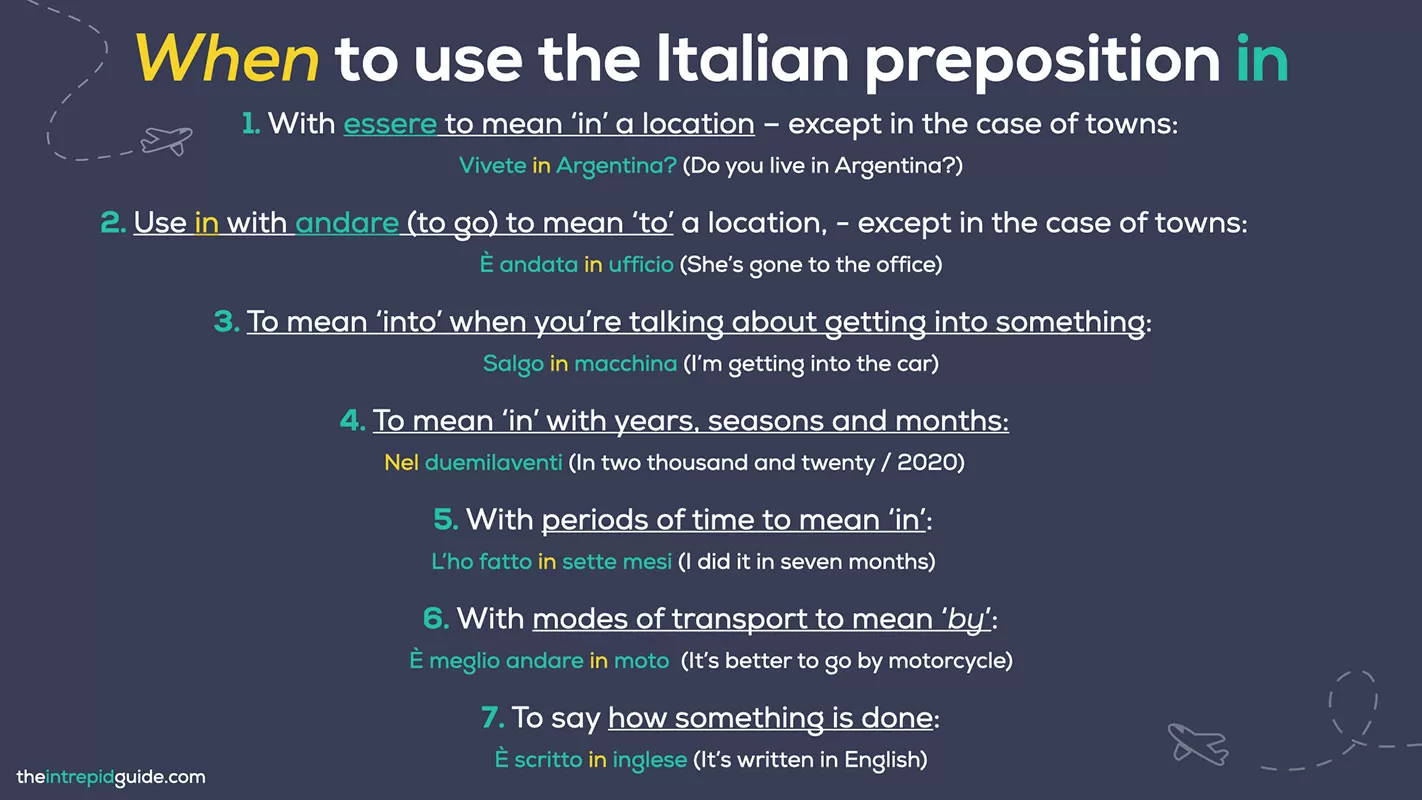 The preposition in is used:
The preposition in is used:
1. With essere to mean ‘in’ when you are talking about where someone or something is – except in the case of towns:
- Vivete in Argentina? (Do you live in Argentina?)
- È nel cassetto (It’s in the drawer)
2. Use in with andare (to go) to mean ‘to’ when you’re talking about where someone or something is going to, except in the case of towns:
- Vado in Spagna questo fine settimana (I’m going to Spain this weekend)
- È andata in ufficio (She’s gone to the office)
3. To mean ‘into’ when you’re talking about getting into something, or putting something into something:
- Salgo in macchina (I’m getting into the car)
- I ladri sono penetrati in banca (The thieves entered [also: penetrated] the bank)
- L’ho gettato in acqua (I threw it into the water)
Note that in is also used with verbs such as dividere (to divide) and tagliare (to cut).
- L’ha tagliato in due (He cut it into two)
4. To mean ‘in’ with years, seasons, months and other expressions of time:
- Nel duemilaventi (In two thousand and twenty / 2020)
- In autunno (In autumn/fall)
- In febbraio (In February)
- Che cosa fai nel fine settimana? (What are you doing on the weekend?)
5. With periods of time to mean ‘in’:
- L’ho fatto in sette mesi (I did it in seven months)
- Possiamo finirlo in trenta minuti (We can finish it in thirty minutes)
6. With modes of transport to mean ‘by’:
- Andiamo in treno, in macchina o in metro? (Are we going by train, by car or by subway?)
- È meglio andare in moto (It’s better to go by motorcycle)
7. To say how something is done:
- A casa parliamo in italiano (At home, we speak in Italian)
- È scritto in inglese (It’s written in English)
Extra tips for using the Italian preposition in:
The expression essere in vacanza means ‘to be on holiday’, and andare in vacanza means ‘to go on holiday’. For example:
- Siamo in vacanza per tutto il mese di luglio. (We are on vacation for the whole month of July)
You don’t use in with adverbs such as qui (here) and lì (there). For example:
- qui dentro (in here) [Literally, ‘here inside’]
- lì dentro (in there) [Literally, ‘there inside’]
How to use the preposition SU
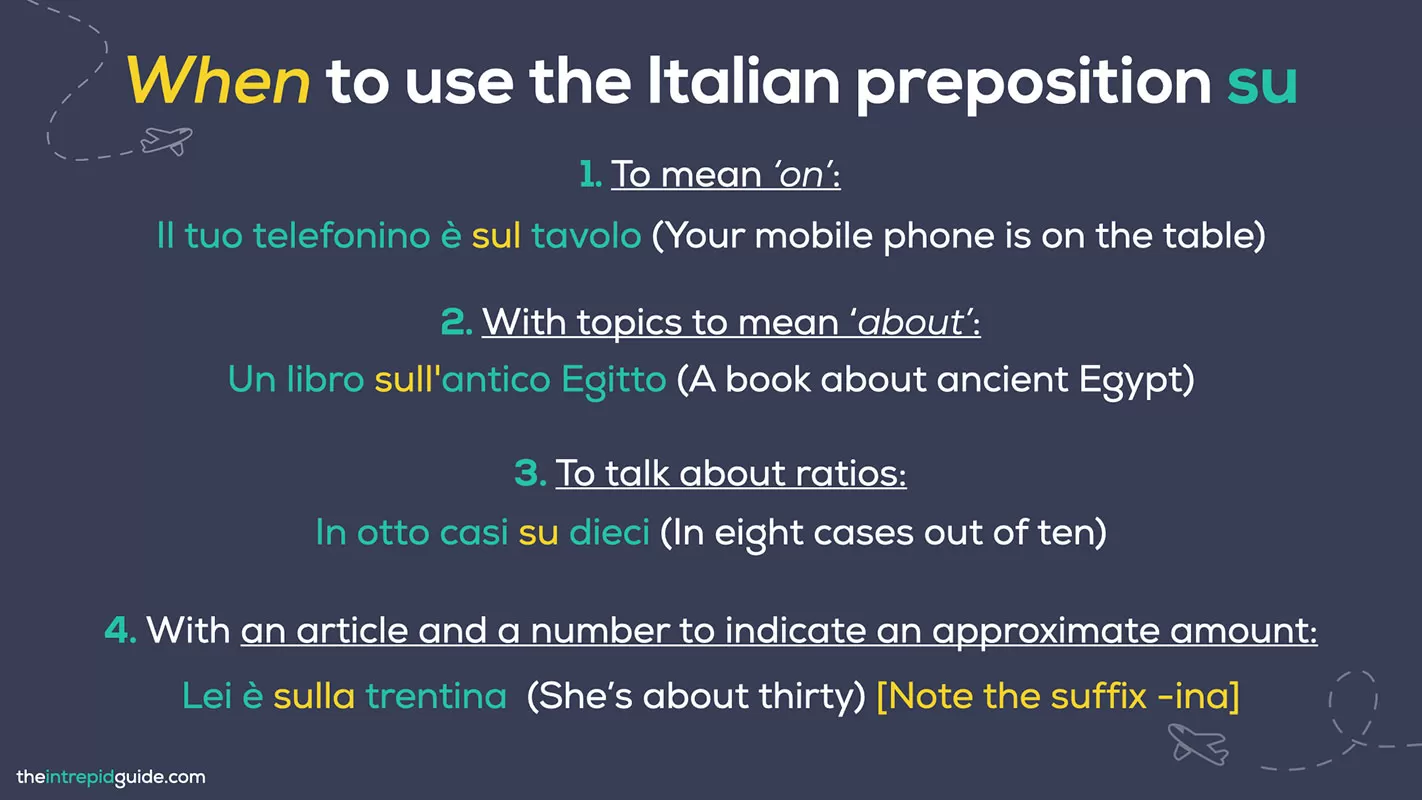 The preposition su is used:
The preposition su is used:
1. To mean on:
- Il tuo telefonino è sul tavolo (Your mobile phone is on the table)
- Lo metto sulla sedia (I’ll put it on the chair)
- C’è una porta in fondo sulla sinistra (There is a door at the bottom on the left)
2. To say ‘in the newspaper’, you use sul
- L’hai letto sul giornale? (Did you read it in the newspaper?)
3. With topics to mean about:
- Un libro sull’antico Egitto (A book about ancient Egypt)
4. To talk about ratios:
- In otto casi su dieci (In eight cases out of ten)
- Due mesi su tre (Two months out of three)
5. With an article and a number to indicate an approximate amount:
- È costato sui trecento euro (It cost around three hundred euros)
- Lei è sulla trentina (She’s about thirty) [Note the suffix -ina]
- Mario ha sui cinquant’anni. (Mario is about fifty)
Extra tips for using the Italian preposition su:
Both qui/qua mean here and qui su and qua su mean up here. You can also combine qua (not qui) with su to make one word: quassù (up here).
To say there is là but to say up there, là combines with su to make one word with a double s: lassù (up there):
- Il gatto è qui su (The cat is up here)
- Lassù qualcuno ci protegge (Up there, someone is looking after us)
How to use the preposition PER The preposition per is used:
The preposition per is used:
1. To mean for:
- Questo è per te (This is for you)
- È troppo difficile per lui (It’s too difficult for him)
- L’ho comprato per undici euro (I bought it for eleven euros)
- Ha guidato per duecento chilometri (He drove for two hundred kilometres)
When you are talking about how long you have been doing something you use da.
- Aspetto da cinque minuti (I’ve been waiting for [also: since] five minutes)
2. With destinations:
- Il volo per Milano (The flight to Milan)
- Il treno per Verona (The train to Verona)
3. With verbs of movement to mean through:
- I gatti sono entrati per la finestra (The cats entered through the window)
- Siamo passati per Catania (We went through Catania)
4. To indicate how something is transported or communicated:
- Per posta (By post)
- Per via aerea (By airmail)
- Per email (By email)
- Per ferrovia (By rail)
- Per telefono (By/on the phone)
Remember that per is NOT used when referring to means of transport for people, in is used instead.
- In macchina (By car)
5. To explain the reason for something:
- L’ho fatto per aiutarti (I did it to help you) [Literally: ‘I did it in order to help you’]
- L’abbiamo fatto per ridere (We did it for a laugh)
- Sono andato là per abitudine (I went there out of habit)
- Non l’ho fatto per cattiveria (I didn’t do it out of malice/to be mean/out of spite)
- È successo per errore (It happened by mistake)
6. In some very common phrases:
- Uno per uno (One by one)
- Giorno per giorno (Day by day)
- Una/o per volta (One at a time)
- Cinque per due (Five times two / 5 x 2)
As you come across new phrases in Italian you’ll start to recognise and remember these rules instinctively.
 Enjoyed this guide? Are you a beginner or an intermediate Italian learner? Got a trip coming up or want to communicate with your Italian partner or relatives in Italian? Learn Italian with my unique 80/20 method
Enjoyed this guide? Are you a beginner or an intermediate Italian learner? Got a trip coming up or want to communicate with your Italian partner or relatives in Italian? Learn Italian with my unique 80/20 method
Registrations are now open to join Intrepid Italian, my new series of online video courses that use my unique 80/20 method. You’ll go from a shy, confused beginner to a proficient and confident intermediate speaker, with me as your trusty guide.
You’ll finally be able to connect with your Italian partner, speak to your relatives and enjoy authentic travel experiences in Italy that you’ve always dreamed of, and so much more.
As a native English speaker who learned Italian as an adult, I know what it’s like to feel hopeless and lack the confidence to speak. I know what it’s like to start from scratch and to even go back to absolute basics and learn what a verb is!
Intrepid Italian was created with YOU in mind. I use my working knowledge of the English language to help you get into the ‘Italian mindset’ so you can avoid the common pitfalls and errors English speakers make – because I made them once too! I break everything down in such a way that it ‘clicks’ and just makes sense.
No matter what your level is, there is an Intrepid Italian course for you, including:
- 🇮🇹 Intrepid Italian for Beginners (A1)
- 🇮🇹 Intrepid Italian for Advanced Beginners (A2)
- 🇮🇹 Intrepid Italian for Intermediates (B1)
You can join 1, 2, or all 3 courses, it’s entirely up to you. The best part is that you have lifetime access so you learn anytime, anywhere and on any device.
As your guide, I walk you through each lesson, step-by-step, using my unique 80/20 method. My approach is different from traditional methods because I teach you the most important 20% of the language right from the beginning so you can start to speak straight away.
Each course includes video lessons, audio exercises, downloadable worksheets, bonus guides, a private support community, and lifetime access all designed to streamline your learning while having fun.
It even comes with my famous Celebrate with a Spritz Guarantee. After 30 days of using Intrepid Italian, if you don’t want to celebrate your newfound Italian skills with an Aperol Spritz, you don’t have to pay a penny! Cheers! 🥂
Join Intrepid Italian here and start learning today!
Ci vediamo lì! (See you there!)

Learning Italian? Check out these Italian language guides
- Italian for Beginners | How to Learn Italian in 3 Simple Steps
- Italian Cognates & Loanwords: 17 Rules to Italianizing English Words You Already Know
- TOP 100 Most Common Italian Words (Plus PDF Cheat-Sheet & Quiz)
- Ultimate Guide to the Italian Alphabet: Letters, Pronunciation, and Stress
- How to say ‘Merry Christmas’ in Italian [Plus New Year Vocabulary and Quiz]
- 34 Words That Don’t Exist in Italian (English Loanwords in Italian)
- Italian Culture: 19 Weird Things Italians Do That No One Warns You About
- 17 Weird Italian Superstitions Italians ACTUALLY Live By
- 17 Must-Know Italian Hand Gestures: The Ultimate Guide
- Top 24 Most Important Verbs in Italian (Plus PDF Cheat-Sheet & Quiz)
- 10 Ways Natives REALLY Say ‘You’re Welcome’ in Italian
- How to say ‘Please’ in Italian in 9 Ways Like a Native
- 41 Italian Greetings: How to Say ‘Hello’ in Italian Like a Local
- 125 Most Common Italian Phrases for Travel You’ll Ever Need [PLUS Printable]
- 8 DEADLY mistakes in Italian (& How to Avoid Them)
- How to Conjugate Italian Verbs in 3 Simple Steps [Italian for Beginners]
- Is Italian Hard to Learn? 7 Common Mistakes & How to Avoid Them
- Master Days of the Week in Italian (7 Simple Memory Hacks)
- Italian Numbers: How to Count in Italian From 0 to 1 Billion (Plus PDF Download)
- How to Order Food & Drinks in Italian [Italian for Beginners]
- 15 Italian Words You Should NEVER Mispronounce [& How Not To]
- 11 Effective Hacks That’ll Help You Learn Italian So Much Faster
- Top 14 Italian Words You Should NEVER Say [& What to Use Instead]
- 20 Hilarious Everyday Italian Expressions You Should Use
- Romanesco: 25 Cool Roman Dialect Words You Should Use in Rome
- 10 Reasons Why Learning Italian Will Change Your Life
- 10 Italian Expressions Italians Love Saying
- 10 Italian Phrases That Will Instantly Make You Sound more Italian
- Funny Italian Sayings: 26 Food-Related Insults You Won’t Forget
- 15 Romantic Italian Films That’ll Make You Love Italy Even More
- How to Master Common Italian Phrases for Travel (Like a Local!)
Like it? Pin it for later!
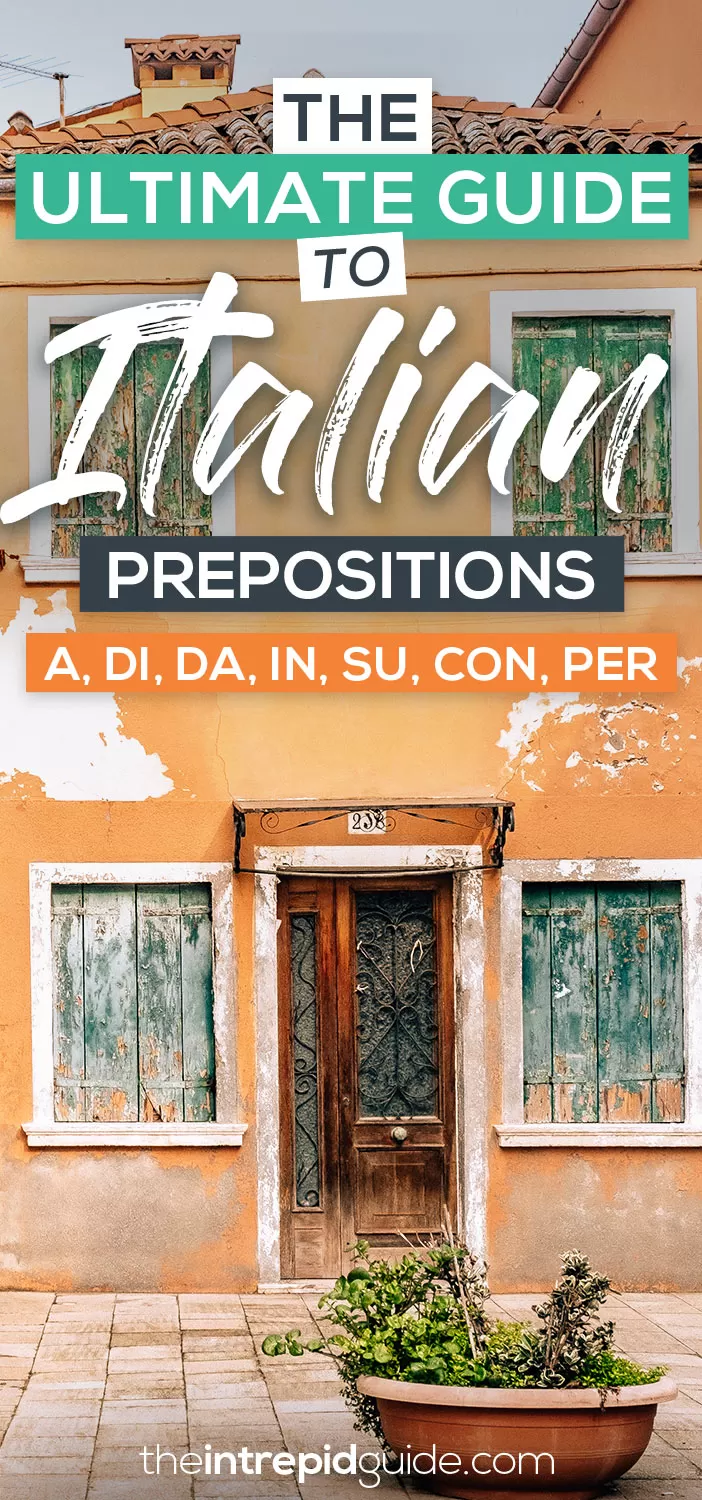
Over to you!
Did you find this guide helpful? Got a question? Let me know using the comments section below or join me on social media @intrepidguide or @intrepiditalian to start a conversation.
Thanks for reading and I hope you enjoyed this post.
Like what you see? Subscribe using the form below to have all of my posts delivered directly to your email.

